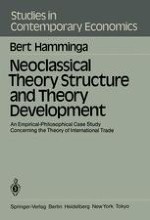There are quite a lot of recent books on the methodology of economics, but all proceed from one or more of the following three fundamental assumptions: 1) Meta-apriorism: it is a priori believed that the results of the philosophy of science of the past decades, associated with the names of Popper, Kuhn and Lakatos, yield conceptual frameworks that can be used to describe the product of the economist's endeavours. 2) Synchronism: it is believed that the inspection of a "theory" of economics, the presentation of some economic belief at a point in time, reveals its logical structure and ipso facto the "method" by which the "theory" is constructed. 3) CreduZity: it is believed that what economists themselves say on their own methods is true, or at least of primary relevance. In this book, I endeavour to show that these assumptions are false. First, the philosophies of science by Popper, Kuhn and Lakatos did not succeed in constructing a conceptual framework capable of describing theory development in economics. Secondly, this can only be seen as soon as not Zogic but history is taken to be the referee judging the adequacy of metatheories (diachronism). Thirdly the results of metaempiricaZ (not-meta-aprioristic), diachronic (not-synchronic) research reveals that even economists themselves turn out frequently to have inadequate metatheories upon which it is dangerous to rely (suspicion instead of credulity) .
